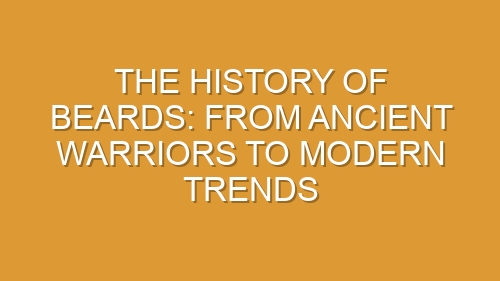-
Table of Contents
Ancient Origins of Beards: Tracing the Evolution of Facial Hair Styles
The History of Beards: From Ancient Warriors to Modern Trends
Beards have been a symbol of masculinity and power throughout history, with their origins dating back to ancient times. Tracing the evolution of facial hair styles allows us to understand the significance and cultural importance of beards in different societies. From ancient warriors to modern trends, the history of beards is a fascinating journey that showcases the ever-changing perceptions and styles of facial hair.
In ancient civilizations, beards were seen as a sign of strength and wisdom. The Egyptians, for example, believed that the beard was a symbol of divinity and authority. Pharaohs and high-ranking officials would often wear false beards made of gold or other precious materials to emphasize their status. Similarly, in ancient Mesopotamia, beards were associated with power and were often depicted on statues of gods and kings.
Moving forward in time, the Greeks and Romans had a different perspective on beards. The Greeks considered a clean-shaven face to be a mark of civilization and sophistication. In fact, Alexander the Great ordered his soldiers to shave their beards to prevent enemies from grabbing onto them during battles. The Romans, on the other hand, embraced beards as a symbol of masculinity and virility. Emperors like Hadrian and Marcus Aurelius were known for their impressive beards, which were seen as a reflection of their authority.
During the Middle Ages, beards took on a religious significance. In Christianity, beards were associated with holiness and were often worn by monks and priests. The long, flowing beards of religious figures were seen as a symbol of their devotion and wisdom. However, as the Renaissance period approached, beards fell out of favor once again. The clean-shaven look became fashionable, with men using various methods to remove their facial hair, including plucking, shaving, and even applying depilatory creams.
The 19th century witnessed a resurgence of beards, particularly during the Victorian era. Beards became a symbol of masculinity and were seen as a mark of maturity and wisdom. Men would often grow elaborate beards and mustaches, using various grooming products to maintain their facial hair. This trend continued into the early 20th century, with iconic figures like Abraham Lincoln and Karl Marx sporting impressive beards.
However, as the 20th century progressed, beards once again fell out of favor. The clean-shaven look became the norm, with societal expectations dictating that men should be well-groomed and free of facial hair. This trend continued well into the late 20th century, with only a few countercultural movements, such as the hippie movement of the 1960s, embracing facial hair.
In recent years, however, beards have made a comeback. The 21st century has seen a resurgence of facial hair, with men of all ages and backgrounds embracing their natural growth. Beards are no longer seen as a symbol of rebellion or nonconformity but rather as a fashion statement and a way for men to express their individuality. From the hipster beard to the well-groomed stubble, there is a wide range of beard styles to choose from, allowing men to experiment and find a look that suits their personality.
In conclusion, the history of beards is a testament to the ever-changing perceptions and styles of facial hair. From ancient warriors to modern trends, beards have played a significant role in different societies throughout history. Whether seen as a symbol of power, holiness, or fashion, beards continue to be a reflection of masculinity and individuality in today’s world. So, whether you choose to embrace your natural growth or opt for a clean-shaven look, remember that the history of beards is a story that continues to evolve.
Beards in History: Symbolism and Significance across Different Cultures
Beards have been a prominent feature of men’s faces throughout history, and their significance and symbolism have varied across different cultures. From ancient warriors to modern trends, the history of beards is a fascinating journey that sheds light on the evolution of masculinity and personal style.
In ancient Egypt, beards were seen as a sign of dignity and wisdom. Pharaohs and high-ranking officials would often wear false beards made of gold or other precious materials to enhance their status. These beards were meticulously crafted and symbolized power and authority.
Moving on to ancient Greece, beards took on a different meaning. In Greek mythology, the god Zeus was often depicted with a long, flowing beard, which represented his wisdom and maturity. Beards were also associated with masculinity and virility, and many Greek men would grow and groom their beards as a symbol of their manhood.
In contrast, ancient Rome had a more complex relationship with beards. During the early Roman Republic, beards were seen as a sign of masculinity and were widely embraced. However, as the Roman Empire expanded, beards became associated with barbarians and were often shaved off to distinguish Romans from their conquered subjects. This trend continued until the reign of Emperor Hadrian, who reintroduced beards as a symbol of Roman identity.
Moving forward in time, the Middle Ages saw beards take on a religious significance. In Christianity, beards were seen as a symbol of holiness and were often worn by monks and religious figures. The length and style of the beard were often dictated by religious orders, with some requiring full beards while others preferred trimmed or shaved faces.
During the Renaissance, beards once again became a fashion statement. European nobility and aristocracy would often grow elaborate beards and mustaches as a way to display their wealth and status. These beards were meticulously groomed and shaped, with some even adorned with jewels or ribbons. However, as the 18th century approached, beards fell out of favor once again, with clean-shaven faces becoming the norm.
Fast forward to the 20th century, and beards experienced a resurgence in popularity. The counterculture movements of the 1960s and 1970s saw many men grow long, unkempt beards as a symbol of rebellion against societal norms. This trend continued into the 21st century, with beards becoming a popular fashion statement among men of all ages.
Today, beards are seen as a personal style choice and can be found in various shapes and sizes. From the full, bushy beards of hipsters to the neatly trimmed beards of businessmen, facial hair has become a way for men to express their individuality and personality. Beards have also become a symbol of masculinity and strength, with many men embracing their facial hair as a way to assert their identity.
In conclusion, the history of beards is a testament to the ever-changing nature of fashion and cultural symbolism. From ancient Egypt to modern trends, beards have held different meanings across different cultures and time periods. Whether it’s a sign of power, wisdom, or personal style, the beard continues to be a prominent feature in the world of men’s fashion. So, whether you choose to grow a beard or not, remember that the history of beards is a rich tapestry that reflects the diversity and evolution of masculinity throughout the ages.
The Resurgence of Beards: Exploring the Modern Beard Trend and its Cultural Impact
The Resurgence of Beards: Exploring the Modern Beard Trend and its Cultural Impact
Beards have made a remarkable comeback in recent years, with men of all ages and backgrounds embracing this facial hair trend. From celebrities to everyday individuals, the modern beard has become a symbol of masculinity, style, and individuality. But what is the history behind this resurgence, and what cultural impact does it have?
To understand the modern beard trend, we must first delve into its historical roots. Beards have been a part of human culture for centuries, with ancient civilizations like the Egyptians, Greeks, and Romans considering them a sign of power, wisdom, and virility. In these societies, beards were often associated with masculinity and were seen as a symbol of authority and respect.
However, as time went on, the perception of beards shifted. In the Middle Ages, beards were associated with barbarism and were often shaved off to conform to societal norms. This trend continued into the Renaissance and the Enlightenment, where clean-shaven faces were seen as a mark of sophistication and refinement.
It wasn’t until the 19th century that beards began to regain popularity. The Victorian era saw a resurgence of facial hair, with men growing elaborate beards and mustaches as a sign of masculinity and social status. This trend continued into the early 20th century, with iconic figures like Abraham Lincoln and Karl Marx sporting their famous beards.
However, as the 20th century progressed, beards once again fell out of favor. The clean-shaven look became the norm, with societal expectations dictating that men should be smooth-faced and well-groomed. This trend continued well into the late 20th century, with beards being seen as unkempt and unprofessional.
But in the early 2000s, a shift began to occur. The modern beard trend started to gain traction, with celebrities like Brad Pitt and George Clooney sporting well-groomed beards on the red carpet. This newfound acceptance of facial hair sparked a cultural shift, with men embracing their natural facial hair and rejecting societal expectations.
The modern beard trend is not just a fashion statement; it has also had a significant cultural impact. For many men, growing a beard is a way to express their individuality and break free from societal norms. It allows them to embrace their natural appearance and challenge traditional notions of masculinity.
Furthermore, the modern beard trend has also become a symbol of rebellion against the clean-shaven corporate world. Many men now see growing a beard as a way to assert their identity and reject the idea that professionalism is tied to appearance. This has led to a more inclusive and accepting workplace culture, where individuals are judged based on their skills and abilities rather than their physical appearance.
In conclusion, the resurgence of beards in recent years has been a remarkable cultural phenomenon. From its historical roots as a symbol of power and masculinity to its modern-day status as a fashion statement and rebellion against societal norms, the modern beard trend has had a significant impact on our culture. It has allowed men to express their individuality, challenge traditional notions of masculinity, and create a more inclusive and accepting society. So, whether you choose to grow a beard or not, it’s clear that the modern beard trend is here to stay.





















